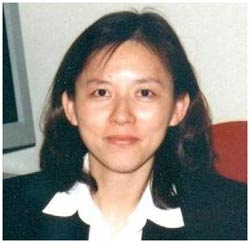The microscope sheds light on the intricacies of protein folds
Physicists in the US say: By using atomic force microscope (AFM) to bend proteins - a new method can give us better understanding of diseases. deadly.
Unlike previous techniques, this technique can map the intermediate energy states of proteins when they are bent - a crucial hope for scientists to find out. Why is folding protein so bad in cases like Alzheimer's disease, Parkinson's disease or CJD (Creutzfeldt Jacob disease or mad cow disease).

Ching-Hwa Kiang
(Photo: Chkiang.rice.edu)
Protein - a component of life - contains a chain of molecules called amino acids that fold into a three-dimensional shape. The AFM technique can be used to study this folding by attaching one end of the protein to the substrate and the other end to the AFM detector (cantilever). When the protein is stretched, the probe is vibrated and the force helps the protein and tip of the probe return to the measured equilibrium position.
Theoretically, this ' unbalanced ' research and evaluation can provide information about the many intermediate equilibrium energy states that proteins must undergo on their way to complete stretching. . However, in fact, the interpretation of data occurs controversy, and so far the researchers have only had a clear understanding of equilibrium at the beginning and end of the folding process. .
Now Ching-Hwa Kiang and colleagues at Rice University developed the AFM technique to identify intermediate states. To do this, they built a computer program based on the equation of the University of Maryland physicist Chris Jarzynski published a decade ago.
Although scientists still believe that the ' Jarzynski equation ' can be used to obtain equilibrium information from measuring information about unbalanced states, no one can apply them. success. 'By exchanging and discussing with Jarzynski, we fully understand how and where the theory applies,' explained Kiang.
The Rice University team demonstrated their technique by using a part of 'titin', the largest known protein so far and a protein that makes the heart's elastic muscle and maps. of eight separate energy states when they use AFM to bend them straight. They say that this is the basis for the study of why environmental changes such as temperature affect protein folding.
Damap
- Microscope and telescope, which is more
- The birth of the microscope
- Searching for the cold feeling
- Super light microscope
- High Speed Microscope
- Why does the microscope output monochrome images?
- Why do trees always grow toward light?
- Google created a augmented reality microscope capable of detecting cancer
- Foldscope - paper microscope to diagnose malaria
- Australia makes 20 times more powerful microscopes today
- Create heart cells who first respond to light
- Polaris neutron microscope: Performing faster measurements
 Why do potatoes have eyes?
Why do potatoes have eyes? 'Tragedy' the world's largest carnivorous life: Death becomes ... public toilet
'Tragedy' the world's largest carnivorous life: Death becomes ... public toilet Tomatoes were once considered 'poisonous' for 200 years
Tomatoes were once considered 'poisonous' for 200 years Detecting microscopic parasites on human face
Detecting microscopic parasites on human face